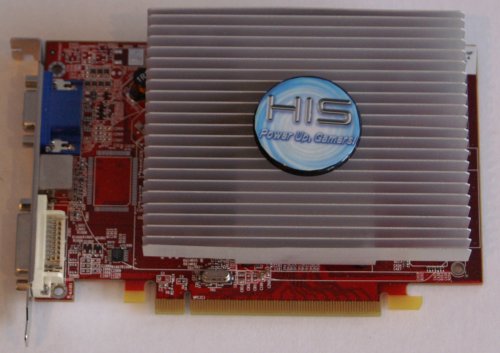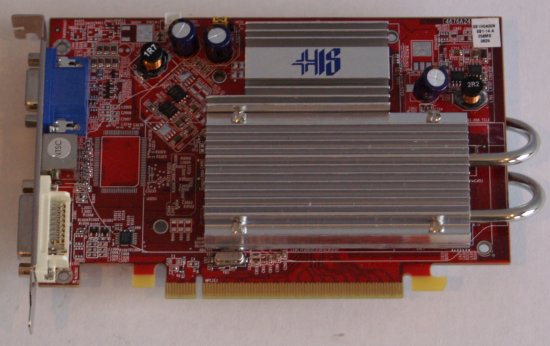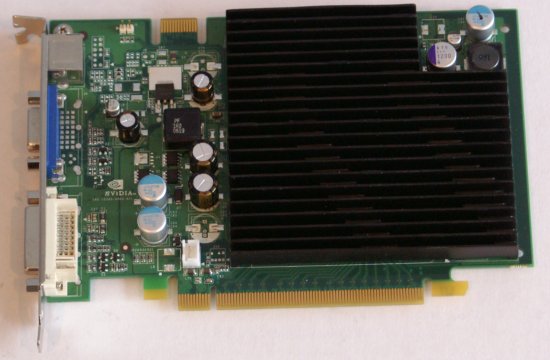HIS

HIS is a company that's well known for its IceQ line of graphics parts, but they also offer silent solutions, and for this review we have two of these. Both use ATI chipsets: the X1600 Pro and X1300 Pro.

The HIS X1600 Pro has a somewhat bulky heat sink design, which has rows of long metal ridges along the whole top of the card. HIS seems to have taken the route of dispelling heat through as much surface area on the heat sink as possible, to good effect. The metal ridges are also much thicker than those on other heat sinks, and the card isn't as delicate as some of the other offerings.

The HIS X1300 Pro has a much more compact heat sink design which extends to the back of the card and is connected via two heatpipes, similar to the ASUS EAX1600 XT. This HIS card has a larger silver heat sink than the ASUS on the front of the card, however, along with a slightly larger sink on the back of about the same thickness.
EVGA

For this review, we have one silent EVGA part, the EVGA e-GeForce 7600 GS. This card is factory clocked at reference speeds (400MHz/800MHz), and sports a modest heat sink design, typical of EVGA. The face of the card has a black heat sink which has rows of thick ridges across the length of it.


HIS is a company that's well known for its IceQ line of graphics parts, but they also offer silent solutions, and for this review we have two of these. Both use ATI chipsets: the X1600 Pro and X1300 Pro.

The HIS X1600 Pro has a somewhat bulky heat sink design, which has rows of long metal ridges along the whole top of the card. HIS seems to have taken the route of dispelling heat through as much surface area on the heat sink as possible, to good effect. The metal ridges are also much thicker than those on other heat sinks, and the card isn't as delicate as some of the other offerings.

The HIS X1300 Pro has a much more compact heat sink design which extends to the back of the card and is connected via two heatpipes, similar to the ASUS EAX1600 XT. This HIS card has a larger silver heat sink than the ASUS on the front of the card, however, along with a slightly larger sink on the back of about the same thickness.
EVGA

For this review, we have one silent EVGA part, the EVGA e-GeForce 7600 GS. This card is factory clocked at reference speeds (400MHz/800MHz), and sports a modest heat sink design, typical of EVGA. The face of the card has a black heat sink which has rows of thick ridges across the length of it.











49 Comments
View All Comments
imaheadcase - Thursday, August 31, 2006 - link
I guess to each his own, i play bf2 on a 19inch CRT monitor at 1024x768. But even if i had a better card i would still prefer lower rez.DerekWilson - Thursday, August 31, 2006 - link
it's an issue of how games work on the inside ...all the objects, shapes, characters, and landscapes are there no matter how you see them. everything is mathematically represented in the software. rendered onto your display is a viewport into the world. this viewport only allows you to see a fixed grid of colors. the color of each pixel is determined by a bunch of factors, but the largest contribution is made by the object that projects onto a particular pixel.
... on second thought, this is too hard for me to explain with out a lot of math. lets look at it another way.
when there's a naked person on tv, they decrease the resolution of the area over the persons naughty bits. this makes it harder to see what's really there because there is a smaller number of large pixels that can only represent one color each. it follows, then, that it would also be harder to shoot the person acurately in said bits.
I think your preference may be based on your experience with performance at higher resolutions. Responsiveness is necessary for a quality experience in games like bf2. If you get a faster card, I would encourage you to at least try a higher resolution.
blckgrffn - Thursday, August 31, 2006 - link
When it is in stock at newegg, its ~$90, not nearly $140.Nat
mostlyprudent - Thursday, August 31, 2006 - link
I would be interested to know how much noise (quantitatively) an actively cooled 7600GS or 7600GT contributes to a system built in a relatively quiet case like an Antec P150. I am familiar with some of the leaf blowers attached to the higher end cards, but wonder how much overall system noise savings you'ld get in the mid-range cards.wilburpan - Thursday, August 31, 2006 - link
One obvious use for silent video cards would be in an HTPC system, where quiet performance would be a priority. Can't have those noisy computer fans intrude on watching Snakes on a Plane, you know. :@) Anyway, it would have been nice to include some video playback benchmarks to see how these cards can handle playing back a 1080p HDTV signal, or similiar tests.ViRGE - Thursday, August 31, 2006 - link
Since HDTV is MPEG2, any modern video card should be able to handle a 1080P signal(since this is an either/or case, it either can or can't). The limitations come in to H.264, where the video decode engine may not be clocked high enough to do higher resolution decoding. Unfortunately, I'm not sure there's any 1080 commerical/usable content that would work with Cyberlink/Intervideo's H.264 decoders(the only ones with GPU acceleration), since Quicktime content doesn't work in those.DerekWilson - Thursday, August 31, 2006 - link
with nvidia, the video decode engine is clocked off the core -- it actually will run better on a card with fewer pipelines and a higher core speed ... iow, the 7600gt is a better video decode graphics card than a 7900gt at default clock speeds.a little counter intuitive, but there it is.
nvidia 7 series parts with a core clock of >450 MHz should have no problem accelerating 1080p decode on players that support purevideo.
MontagGG - Thursday, August 31, 2006 - link
Which of these have HDCP?DerekWilson - Thursday, August 31, 2006 - link
to my knowledge, none of the cards tested here support hdcp. but I will certainly try to confirm this ...